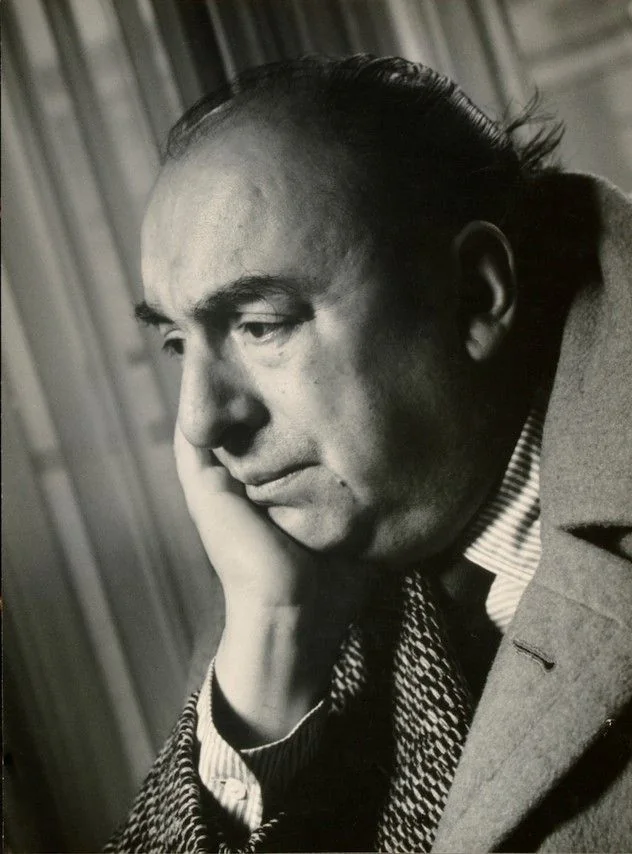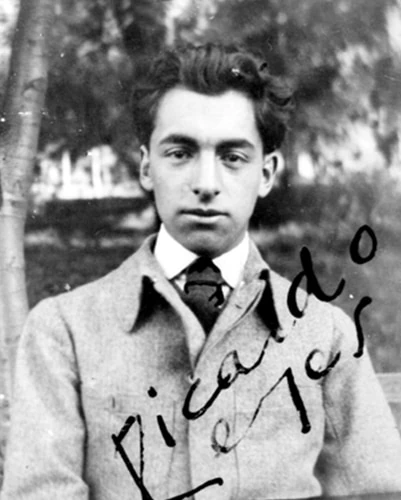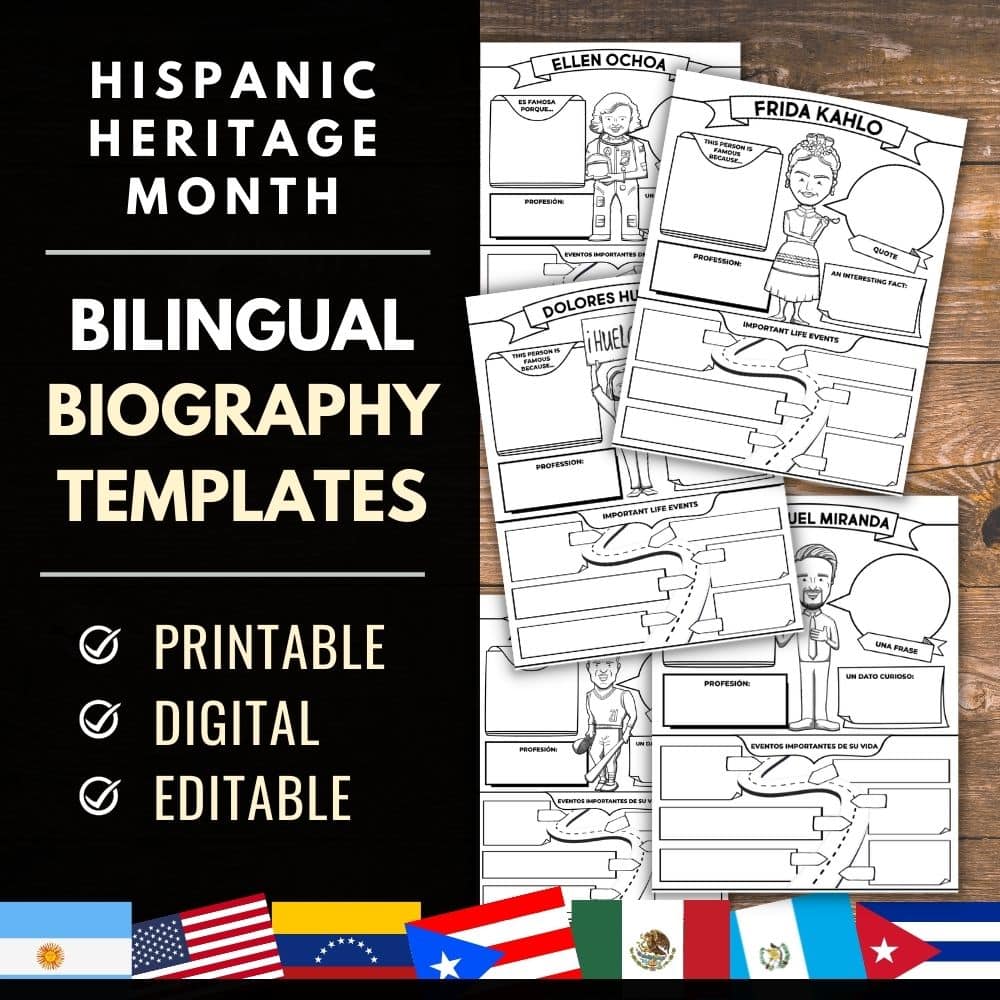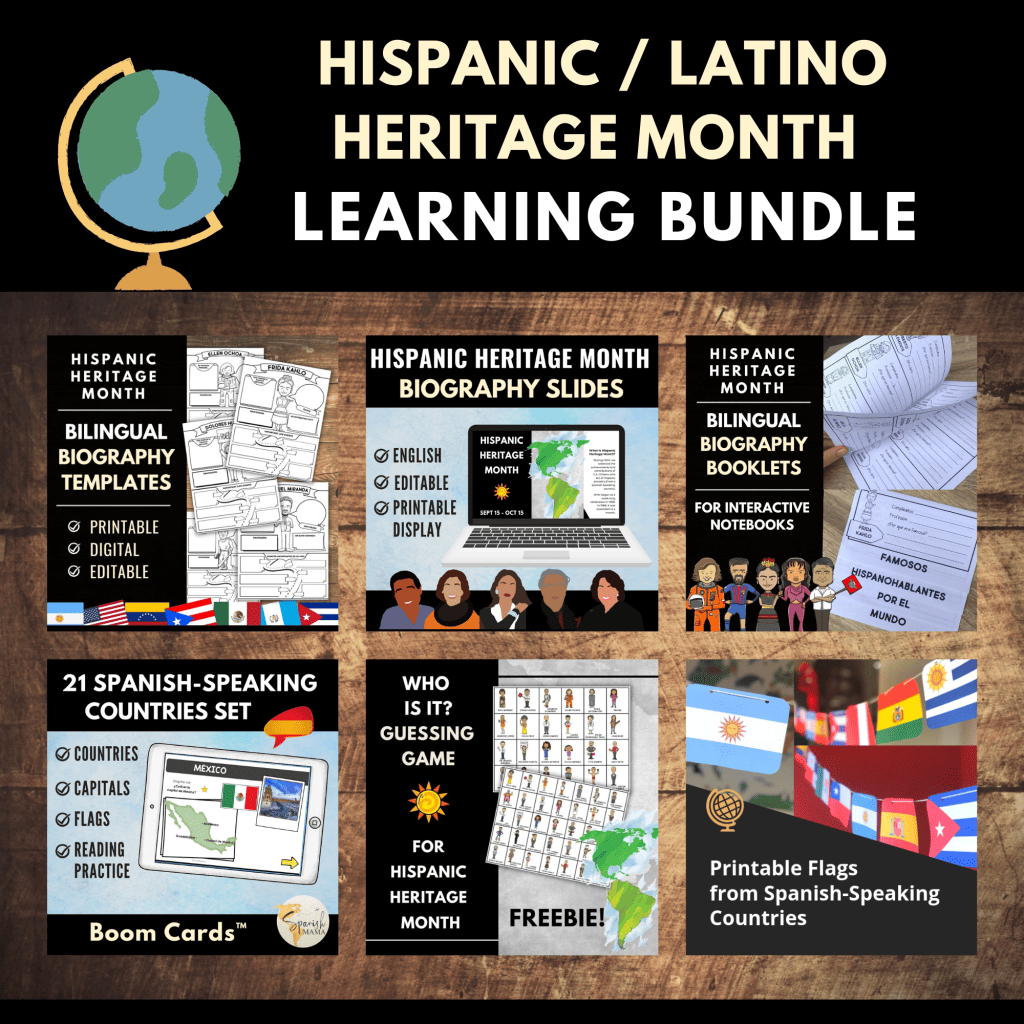Pablo Neruda Poemas (Love Sonnets and Poems in Spanish) and Lessons
Inside: A collection of Pablo Neruda poems — Pablo Neruda poems in Spanish and love sonnets in Spanish– with a biography and lesson plans for teachers.
Pablo Neruda was a Chilean poet and diplomat, and winner of the 1971 Nobel Prize in Literature.
Though his legacy is not without controversy– due to both his political views and personal life– Neruda was an extraordinarily prolific writer, and possibly the most widely read poet of the 20th century. He rose from humble circumstances to become an internationally recognized writer and diplomat.
“[Pablo Neruda] is the greatest poet of the 20th century—in any language.”
– Gabriel García Márquez
Here’s an index of what’s included in the post. You can click on any link to jump straight to that section:
1. Pablo Neruda Biography
2. Pablo Neruda’s Daughter: A Sad Story
3. Pablo Neruda Love Sonnets
Pablo Neruda Sonnet 17 in Spanish
Pablo Neruda Sonnet 11 in Spanish
Pablo Neruda Sonnet 22 in Spanish
4. Pablo Neruda Famous Poems in Spanish
Pablo Neruda A Song of Despair in Spanish
Pablo Neruda Explico algunas cosas
Pablo Neruda Oda a la primavera
Pablo Neruda Cherry Tree Poem in Spanish (Poema 14)
Pablo Neruda Si tú me olvidas
5. Lesson Plans for Students to Learn More
6. YouTube Biography Videos
Related: Famous Latinos & Hispanic Americans Home Page
Pablo Neruda Biography
Pablo Neruda was born July 12, 1904, in Parral, Chile. His given name at birth was Ricardo Eliecer Neftalí Reyes Basoaltoa. His father worked for the railroads. His, mother, a teacher, died from tuberculosis when he was only a few months old.
Ricardo started writing at a young age, which displeased his father, so be began writing under the name Pablo Neruda at 17 years old. He also moved to Santiago to study at the University of Chile, and published his first collection of poetry in 1923.
In 1924, Neruda published his famous Vent Poemas de amor y tuna canción desesperada (Twenty Love Poems and A Song of Despair), which launched him into fame as a writer.
The earnings from writing were small, so he sought a position as poet-diplomat in 1927. This initiated his time of trave, and during his travels to Europe, he met and married his first wife, Maryka Antonieta Hagenaar Vogelzang. They had one daughter, who had hydrocephaly and died at 8 years old.
He joined his lover Delia Del Caril in 1936, though Chile did not recognize their later marriage nor his divorce and abandonment of Maryka. He spent time in Southeast Asia, witnessing oppression and poverty. This inspired his famous and dark work, Residencia en la tierra, first published in 1933.
When Neruda became outspoken on his communist views as Civil War broke out in Spain, he was removed as diplomat. He was reinstated in 1939 as consul to Mexico, however. He joined the Chilean senate in 1944 as a communist, retiring several years later to write.
Neruda published Canto general (General Song) in 1950, an epic poem exploring the history of exploitation in Latin America. His acceptance of the Stalin Prize 1950 from the Soviet Union drew sharp criticism, as did his Lenin Peace Prize in 1953.
divorced and remarried in 1955. Neruda ran for President in 1970 and was appointed ambassador to Paris when his friend Salvador Allende won.
Though Pablo Neruda was nominated for Nobel Prizes many times, his entanglements with the Soviet Union may have prevented him from winning. Finally, in 1971, he won the Nobel Prize for literature. Even then he had detractors.
Neruda had cancer and reportedly died of it, in 1973. However, he died only two weeks after his friend Salvador Allende was ousted and the government overthrown. Through the Chilean government denies any foul play, it is possible he was instead assassinated.
Neruda legacy as a writer is enormous, as “easily the most prolific and popular of all twentieth-century poets. His collected poems run in excess of thirty-five hundred pages, and his books, which have been translated into dozens of languages, have sold in the millions.”
“…There is something about Neruda—about the way he glorifies experience, about the spontaneity and directness of his passion—that sets him apart from other poets. It is hard not to be swept away by the urgency of his language…” – The New Yorker
Pablo Neruda Daughter
There is a dark underside to the life and legacy of Pablo Neruda, one that has recently garnered more attention.
Neruda had a daughter from his first marriage, Malva Marina Trinidad Reyes. Malva was born with hydrocephalus and only lived to the age of 8. Neruda hid his daughter for a time and allegedly described her in cruel terms: ” a three-kilogram vampire” and “a perfectly ridiculous being.”
Neruda eventually abandoned both his wife and daughter, neglecting to provide for them both financially and emotionally. He never saw his daughter after the age of two.
“Neruda…is as much remembered in his native Chile for his socialist political ideas as for his writing. And yet, he denied Hagenaar money needed to care for a child he stopped seeing when she was just two years old. Later, he refused to arrange their safe passage out of Europe during World War II.” – WorldCrunch
This is a devastating truth to know about such a celebrated public figure. Neruda’s name has also come under fire for committing sexual assault on a trip to Sri Lanka. It was recorded in his memoir 40 years ago, but only recently caught public attention.
What to with this complicated legacy: unquestioned genius, social activism, together with obviously horrific acts?
It’s under debate in Chile, especially. Famous Chilean author Isabel Allende criticized his personal acts, while urging us to continue to appreciate his writing.
Some feminist groups say we have to talk about his personal life more.
“It is time to stop idolizing Neruda and talk about the fact that he was abusive,” said Vergara Sánchez. “Just because he is a famous artist does not exempt him from being a rapist.” – The Guardian
Famous Pablo Neruda Poems SOnnets
You can see an index of all 100 Pablo Neruda sonnets here.
Keep reading for a glimpse into several of his most famous sonnets:
1. Pablo Neruda Sonnet 17
No te amo como si fueras rosa de sal, topacio
o flecha de claveles que propagan el fuego:
te amo como se aman ciertas cosas oscuras,
secretamente, entre la sombra y el alma.
Te amo como la planta que no florece y lleva
dentro de sí, escondida, la luz de aquellas flores,
y gracias a tu amor vive oscuro en mi cuerpo
el apretado aroma que ascendió de la tierra.
Te amo sin saber cómo, ni cuándo, ni de dónde,
te amo directamente sin problemas ni orgullo:
así te amo porque no sé amar de otra manera,
sino así de este modo en que no soy ni eres,
tan cerca que tu mano sobre mi pecho es mía,
tan cerca que se cierran tus ojos con mi sueño.
2. Pablo Neruda Sonnet 11
“Tengo hambre de tu boca, de tu voz, de tu pelo
y por las calles voy sin nutrirme, callado,
no me sostiene el pan, el alba me desquicia,
busco el sonido líquido de tus pies en el día.
Estoy hambriento de tu risa resbalada,
de tus manos color de furioso granero,
tengo hambre de la pálida piedra de tus uñas,
quiero comer tu piel como una intacta almendra.
Quiero comer el rayo quemado en tu hermosura,
la nariz soberana del arrogante rostro,
quiero comer la sombra fugaz de tus pestañas.
y hambriento vengo y voy olfateando el crepúsculo
buscándote, buscando tu corazón caliente
como un puma en la soledad de Quitratúe.“
3. Pablo Neruda Sonnet 22
Cuántas veces, amor, te amé sin verte y tal vez sin recuerdo,
sin reconocer tu mirada, sin mirarte, centaura,
en regiones contrarias, en un mediodía quemante:
eras sólo el aroma de los cereales que amo.
Tal vez te vi, te supuse al pasar levantando una copa
en Angol, a la luz de la luna de Junio,
o eras tú la cintura de aquella guitarra
que toqué en las tinieblas y sonó como el mar desmedido.
Te amé sin que yo lo supiera, y busqué tu memoria.
En las casas vacías entré con linterna a robar tu retrato.
Pero yo ya sabía cómo era. De pronto
mientras ibas conmigo te toqué y se detuvo mi vida:
frente a mis ojos estabas, reinándome, y reinas.
Como hoguera en los bosques el fuego es tu reino.
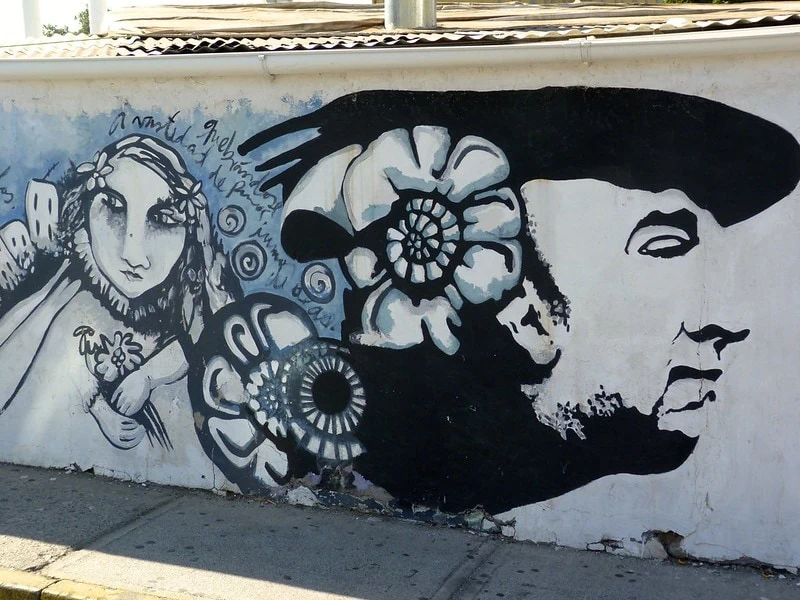
Famous Pablo Neruda PoemAs / Poems in Spanish
Some of these are complete, and others are excerpts of longer Pablo Neruda’s longer poems, with links to the full text.
1. Poema 14 (Cherry Tree Poem)
“Mis palabras llovieron sobre ti acariciándote.
Amé desde hace tiempo tu cuerpo de nácar soleado.
Hasta te creo dueña del universo.
Te traeré de las montañas flores alegres, copihues,
avellanas oscuras, y cestas silvestres de besos.
Quiero hacer contigo
lo que la primavera hace con los cerezos.”
See the full poem here.
2. Explico Algunas Cosas
“Preguntaréis: ¿Y dónde están las lilas?
¿Y la metafísica cubierta de amapolas?
¿Y la lluvia que a menudo golpeaba
sus palabras llenándolas
de agujeros y pájaros?
Os voy a contar todo lo que me pasa.“
See the full poem here.
3. Oda a la primavera
“Todo ha florecido en
estos campos, manzanos,
azules titubeantes, malezas amarillas,
y entre la hierba verde viven las amapolas.
El cielo inextinguible, el aire nuevo
de cada día, el tácito fulgor,
regalo de una extensa primavera.
Sólo no hay primavera en mi recinto.
Enfermedades, besos desquiciados,
como yedras de iglesia se pegaron
a las ventanas negras de mi vida
y el sólo amor no basta, ni el salvaje
y extenso aroma de la primavera.“
See the full poem here.
4. Era mi corazón un ala viva y turbia
Era mi corazón un ala viva y turbia…
un ala pavorosa llena de luz y anhelo.
Era la primavera sobre los campos verdes.
Azul era la altura y era esmeralda el suelo.
Ella -la que me amaba- se murió en primavera.
Recuerdo aún sus ojos de paloma en desvelo.
Ella -la que me amaba- cerro sus ojos… tarde.
Tarde de campo, azul.
Tarde de alas y vuelos.
Ella -la que me amaba- se murió en primavera…
y se llevó la primavera al cielo.
5. Amor
“Mujer, yo hubiera sido tu hijo, por beberte
la leche de los senos como de un manantial,
por mirarte y sentirte a mi lado y tenerte
en la risa de oro y la voz de cristal.
Por sentirte en mis venas como Dios en los ríos
y adorarte en los tristes huesos de polvo y cal,
porque tu ser pasara sin pena al lado mío
y saliera en la estrofa -limpio de todo mal-.
Cómo sabría amarte, mujer, cómo sabría
amarte, amarte como nadie supo jamás!
Morir y todavía
amarte más.
Y todavía
amarte más
y más.
See the full poem here.
6. Si Tú Me olvidas
Si de pronto
me olvidas
no me busques,
que ya te habré olvidado.
Si consideras largo y loco
el viento de banderas
que pasa por mi vida
y te decides
a dejarme a la orilla
del corazón en que tengo raíces,
piensa
que en ese día,
a esa hora
levantaré los brazos
y saldrán mis raíces
a buscar otra tierra.
Pero
si cada día,
cada hora
sientes que a mí estás destinada
con dulzura implacable.
Si cada día sube
una flor a tus labios a buscarme,
ay amor mío, ay mía,
en mí todo ese fuego se repite,
en mí nada se apaga ni se olvida,
mi amor se nutre de tu amor, amada,
y mientras vivas estará en tus brazos
sin salir de los míos.
See the full poem here.
7. Twenty Love Poems and a Song of Despair
Twenty Love Poems and a Song of Despair recently passed into the public domain, and you can access the entire document online, here.
A Song of Despair – Hear the audio of Neruda himself reciting this poem, in Spanish.
“Emerge tu recuerdo de la noche en que estoy.
El río anuda al mar su lamento obstinado.
Abandonado como los muelles en el alba.
Es la hora de partir, oh abandonado!
Sobre mi corazón llueven frías corolas.
Oh sentina de escombros, feroz cueva de náufragos!
En ti se acumularon las guerras y los vuelos.
De ti alzaron las alas los pájaros del canto.
Todo te lo tragaste, como la lejanía.
Como el mar, como el tiempo. Todo en ti fue naufragio!“
See the full poem here.
Pablo Neruda Lesson Plans and Activites
Free Resources for students:
- Books Rags has an extensive set of lesson plans available for teachers who want to do an entire Pablo Neruda unit. “The Lesson Plan Calendars provide daily suggestions about what to teach. They include detailed descriptions of when to assign reading, homework, in-class work, fun activities, quizzes, tests and more. Use the entire Pablo Neruda: Selected Poems calendar, or supplement it with your own curriculum ideas. Calendars cover one, two, four, and eight week units.“
- Lesson Plan on the poem “Ode to My Socks” in English.
Freebies from TpT: - Quick and simple idea for starting a poetry unit with a Pablo Neruda’s “Poetry” poem (in English).
- Who Said It? printable to “create an interactive Wall or Bulletin Board that students can use to read verses by either Enrique Iglesias or Pablo Neruda. When they flip up the verse, the card will let the students know who said it.”
- Questions in Spanish to go with the poem Te Amo by Pablo Neruda.
- Free Lesson for Spanish learners for Valentine’s Day on Neruda’s poetry (high school).
You can check out these resources as well, for more:
Pablo Neruda Biography Videos
An illustrated biography of Pablo Neruda in Spanish:
Short Neruda biography for kids:
Here is a biography in English as well:
Image Sources:
“Pablo Neruda – Santiago, Chile” (CC BY-SA 2.0) by rafa-alves

